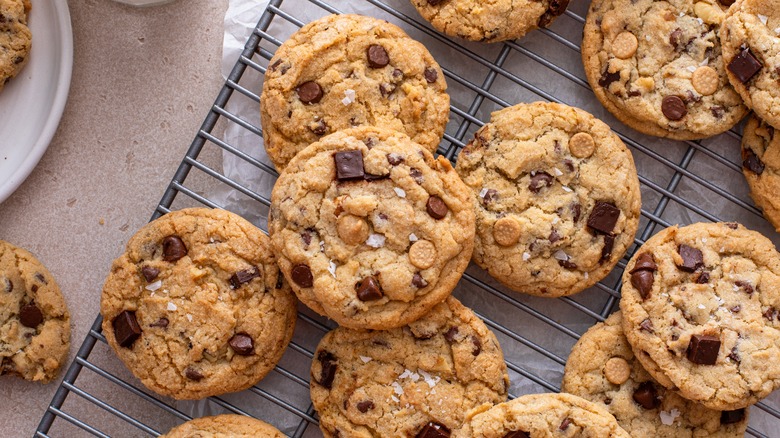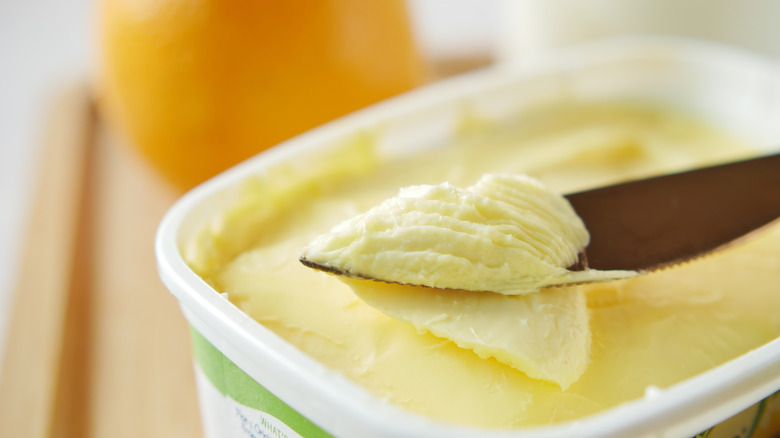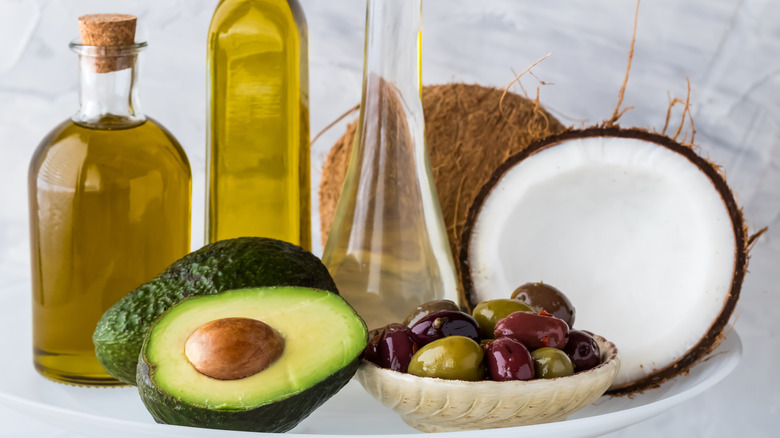Butter Shouldn't Be The Only Fat You Use When Making Cookies
Butter is a rock star when it comes to adding rich flavor and creamy texture to many baked goods, but more doesn't always mean better. Case in point: cookies. Butter is an essential ingredient of course, but you should actually be mixing it with margarine to make a batch that is truly irresistible.
Margarine is made with water and vegetable oils. So, when it's added to cookie dough, it hydrates everything, making the dough easier to work with and preventing the cookies from drying out in the oven. Butter, on the other hand, is made of butterfat, milk solids, and water. Its higher fat content lends that classic, rich flavor to baked goods. So, when the two work together, they give cookies their nice, soft texture and irresistible taste.
But make sure to have the right combination of the two ingredients. Add too much margarine and your cookie dough will be too wet, resulting in the cookies spreading too thin in the oven and burning. Adding too much butter will result in greasy, crumbly cookies with an overpowering butter flavor.
How to mix butter and margarine for the best cookies
Your best bet is to combine equal amounts of butter and margarine for the best cookie results. So, if a recipe calls for 1 cup of butter, use a 1/2-cup of that plus a 1/2-cup of margarine.
Another point to keep in mind is using the same format of ingredients. Margarine comes in three different forms: Liquid margarine, which is often sold in a spray bottle; margarine spread, which comes in a tub; and hard margarine, which comes in stick form. When using a combination of both baking fats to make cookies, make sure they are in the same form and at the same temperature.
For example, when a recipe calls for stick butter, you should use stick margarine, too. If a recipe says to use melted butter, be sure to melt your margarine down as well. Then, mix your baking fats by hand or with an electric mixer before adding to your cookie dough to ensure both ingredients are evenly dispersed.
While margarine and butter are almost always a good combination for cookies, there are a few instances where you should stick to butter only — for example, when making cookies that boast a buttery flavor upfront, like shortbread.
Coconut oil, olive oil, and avocado work wonders as fats, too
If you'd rather not use butter or margarine in your cookie recipe, there are plenty of other oil substitutes for every occasion. Coconut oil, for example, can be used as a 1:1 substitute for butter or other baking fats when making cookies. Just be sure to be mindful when choosing refined vs. unrefined options. Refined coconut oil has a neutral flavor that will go well with any cookies. Unrefined coconut oil also works well in baking but will have a noticeable coconut taste, so it's best used in cookies where you'd want a hint of it.
It might sound odd to make your dessert with savory olive oil, but it too is a great substitution for butter when making cookie dough. Generally, use 3/4-cup olive oil to replace 1 cup of butter. But, it should only be used in recipes that don't require creaming your butter. Creamed butter brings a light texture to the dough, and since olive oil can't whip up or get fluffy, this would alter the intended texture.
Avocado is another pure fat ingredient that can replace butter, and in fact, it can be the secret to ultra-moist chocolate chip cookies. Avocados have a 1:1 ratio when replacing butter in baked goods. Since avocados are mild in flavor, full of nutritious fats, and have a texture similar to softened butter once they're pureed, they'll fit into most cookie recipes seamlessly.



